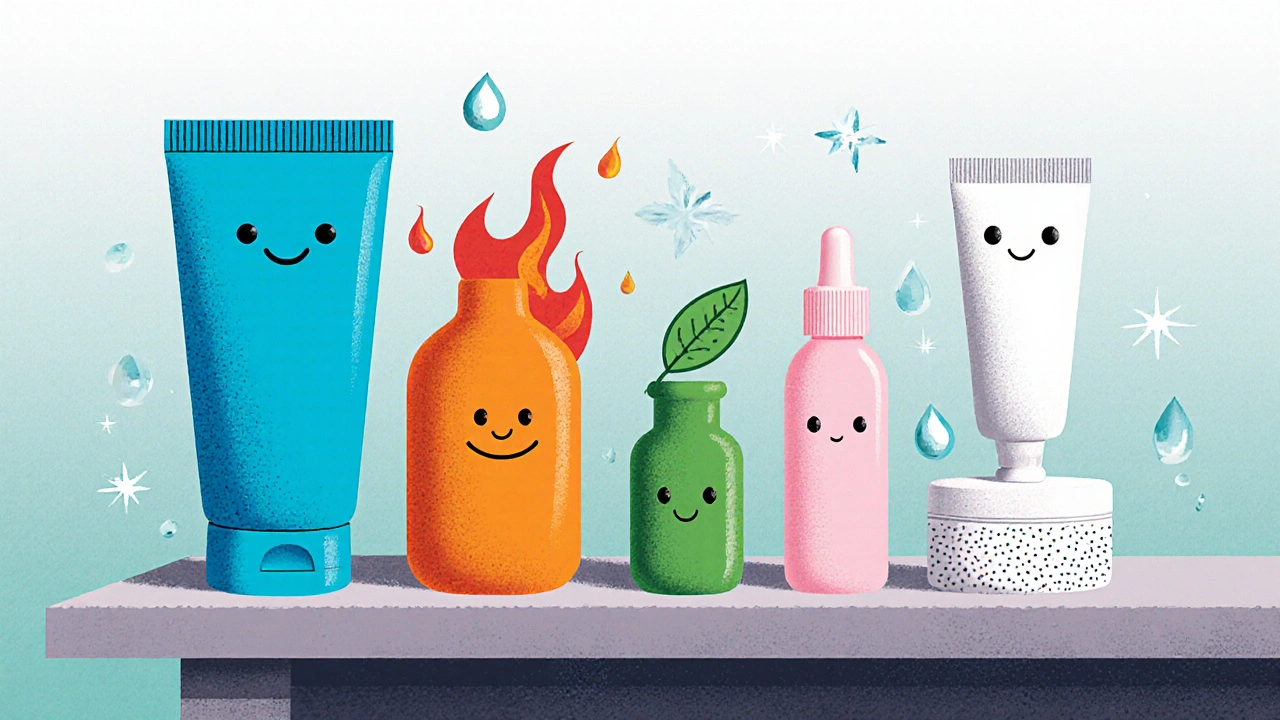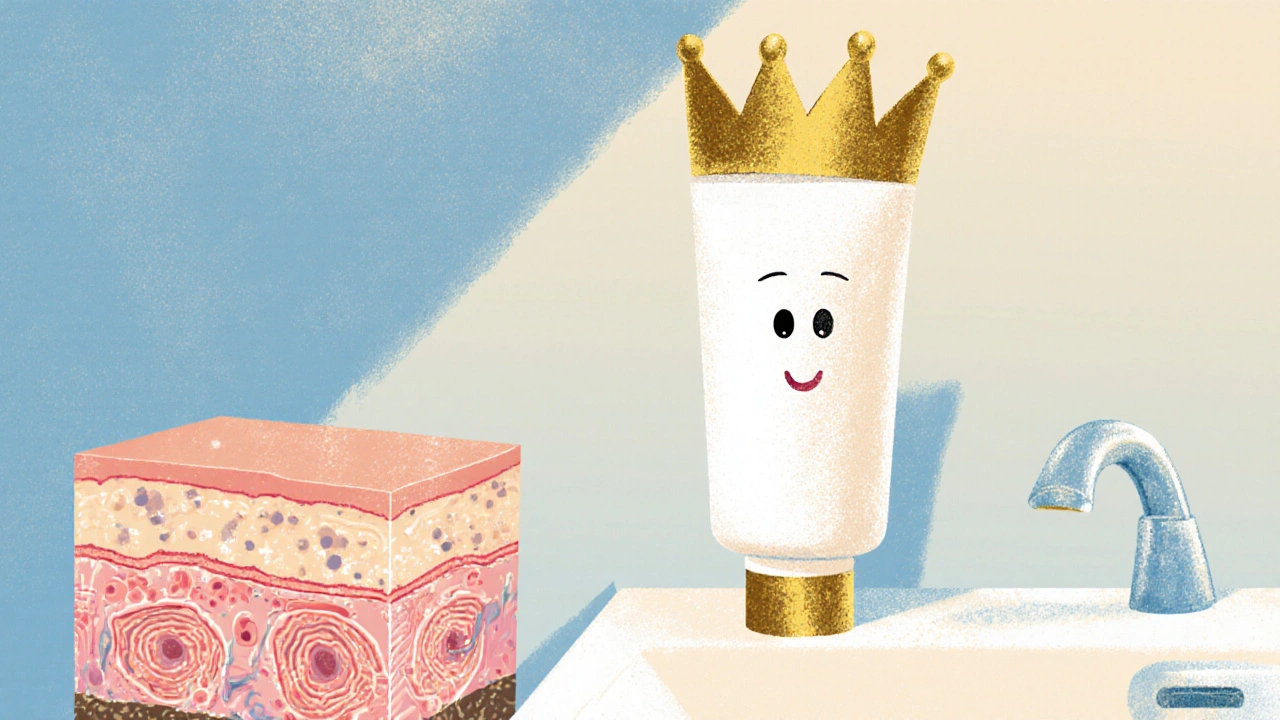Personalized Retinoid Recommendation Tool
Select your skin concerns and preferences to get tailored recommendations for retinoid products
Key Takeaways
- Tretinoin 0.025% remains the gold‑standard prescription retinoid for acne and photo‑aging, but several lower‑cost or over‑the‑counter options can work for milder cases.
- Adapalene 0.1% and Tazarotene 0.05% offer comparable efficacy with different irritation profiles.
- OTC retinol and bakuchiol provide gentler alternatives for beginners or sensitive skin, though they act slower.
- Choosing the right product depends on prescription status, skin tolerance, and treatment goals.
- Always patch‑test and consult a dermatologist before starting a new retinoid.
What Is Tretinoin 0.025%?
Tretinoin 0.025% is a prescription‑strength topical retinoid, a vitamin A derivative that promotes cell turnover and collagen production. It is typically sold as a cream or gel and is approved for acne vulgaris and photodamage.
How Tretinoin Works
The active molecule binds to retinoic acid receptors (RAR‑α, RAR‑β, and RAR‑γ) in the epidermis. This triggers gene expression that speeds up desquamation, reduces keratin plug formation, and diminishes inflammatory mediators. The result is fewer comedones, smoother texture, and faded hyperpigmentation.
Who Should Use Tretinoin 0.025%?
Ideal candidates are teenagers or adults with moderate to severe acne, or individuals seeking to treat fine lines, uneven tone, and sun‑damage signs. Because it can cause irritation, it’s less suited for very sensitive skin or those who cannot tolerate prescription products.

Topical Retinoid Alternatives
Below are the most common alternatives, grouped by prescription status and strength.
Adapalene 0.1% (OTC)
Adapalene is a third‑generation synthetic retinoid available over the counter in 0.1% cream or gel. It binds primarily to RAR‑β and RAR‑γ, offering a balance of efficacy and lower irritation than tretinoin.
Tazarotene 0.05% (Prescription)
Tazarotene is a potent retinoid pro‑drug that converts to tazarotenic acid in the skin. It targets all three RAR subtypes and is especially effective for psoriasis and severe acne, but it can be harsh on delicate skin.
Topical Isotretinoin (0.05% Gel) (Prescription)
While oral isotretinoin is famous for severe nodular acne, a low‑dose gel (0.05%) provides a direct, localized retinoid effect with fewer systemic risks. It works similarly to tretinoin but is often reserved for patients who have already tried other retinoids.
Retinol (OTC, 0.5%-1%)
Retinol is a natural form of vitamin A that the skin converts into retinaldehyde and then to tretinoin. Because conversion is gradual, retinol is gentler but requires several weeks to months for noticeable results.
Bakuchiol (Plant‑Based, 0.5%-1%)
Bakuchiol, derived from the Psoralea corylifolia seed, mimics retinoid pathways without binding to RARs. Clinical tests show comparable improvement in fine lines and pigmentation with far less irritation, making it popular among sensitive‑skin users.
Azelaic Acid 15% (Prescription or OTC in some regions)
Although not a retinoid, azelaic acid shares anti‑comedogenic and anti‑inflammatory actions. It’s a good backup for patients who cannot tolerate any retinoid at all.
Side‑Effect Profile Across Alternatives
- Common irritation: redness, peeling, dryness - most pronounced with tretinoin and tazarotene.
- Photosensitivity: all retinoids increase sun sensitivity; sunscreen is mandatory.
- Purging: an initial breakout can happen with all retinoids as follicles clear.
- Systemic risk: only oral isotretinoin poses systemic teratogenic risk; topical forms are safe when used as directed.
Comparison Table
| Active Ingredient | Typical Concentration | Prescription? | Primary Uses | Typical Side Effects |
|---|---|---|---|---|
| Tretinoin | 0.025% | Yes | Acne, photodamage, fine lines | Redness, peeling, photosensitivity |
| Adapalene | 0.1% | No (OTC) | Mild‑moderate acne | Mild irritation, dryness |
| Tazarotene | 0.05% | Yes | Severe acne, psoriasis | Strong irritation, peeling |
| Isotretinoin (gel) | 0.05% | Yes | Acne resistant to other retinoids | Dryness, mild irritation |
| Retinol | 0.5%-1% | No (OTC) | Anti‑aging, mild acne | Gradual irritation, slow results |
| Bakuchiol | 0.5%-1% | No (OTC) | Anti‑aging, hyperpigmentation | Very low irritation |
| Azelaic Acid | 15% | Both (depends on region) | Acne, rosacea, hyperpigmentation | Mild tingling, dryness |
Pros and Cons Summary
Pros of Tretinoin 0.025%: Highest efficacy for both acne and photo‑aging, extensive clinical data, and strong dermatologist endorsement.
Cons: Prescription requirement, higher irritation risk, and need for strict sun protection.
When to Choose a Milder Alternative: If you have sensitive skin, are new to retinoids, or need an over‑the‑counter option for maintenance.
Decision Guide - Which Product Is Right for You?
- Assess skin tolerance. If you’ve never used a retinoid, start with retinol or bakuchiol.
- Define your primary goal. For fast acne clearance, prescription tretinoin or tazarotene are best. For gradual anti‑aging, retinol or bakuchiol work well.
- Check prescription access. If you can see a dermatologist, ask about a short trial of tretinoin 0.025%.
- Consider cost. OTC options (adapalene, retinol) are cheaper and widely available.
- Plan a skin‑care routine. Pair any retinoid with a gentle cleanser, moisturizer, and broad‑spectrum SPF 30+.
Remember to introduce the product slowly - start with two evenings per week and increase as tolerated.
Frequently Asked Questions
Can I use Tretinoin 0.025% if I’m pregnant?
No. Tretinoin is classified as Category C - it may cause fetal harm. Switch to a pregnancy‑safe option like azelaic acid under medical supervision.
How long does it take to see results with Tretinoin?
Most users notice improvement in skin texture and reduced breakouts after 6‑8 weeks. Full anti‑aging benefits can take 4‑6 months.
Is Adapalene as effective as Tretinoin for acne?
Adapalene works well for mild‑to‑moderate acne with less irritation, but Tretinoin typically clears moderate to severe cases faster.
Can I combine Tretinoin with other active ingredients?
Yes, but be cautious. Vitamin C and niacinamide are generally safe. Avoid using benzoyl peroxide or other strong acids at the same time - alternate mornings and evenings.
What’s the biggest difference between Bakuchiol and Retinol?
Bakuchiol activates similar collagen pathways without the conversion steps retinol needs, so it causes far less redness and is suitable for ultra‑sensitive skin.
Bottom line: Tretinoin 0.025% still leads the pack for potency, but a thoughtful assessment of skin type, goals, and prescription access will help you pick the most comfortable and cost‑effective alternative.


Eryn Wells
Wow, what a thorough rundown! 🌟 The comparison really helps anyone trying to decide between prescription power and gentle OTC options. I love how you highlighted the need for sunscreen – that can’t be stressed enough. Also, the table makes it super easy to visualise the differences. Thanks for the inclusive guide!
Kathrynne Krause
Totally agree, Eryn! 🎨 This post is like a rainbow of skin‑care wisdom, splashing colour across the often‑grey world of retinoids. Starting with retinol or bakuchiol for the newbies is a brilliant suggestion – it’s like easing into a sunrise 🌅. And the reminder to patch‑test? Pure gold. Keep the vibrant vibes coming!
Rachel Valderrama
Oh great, another retinoid guide – because my skin didn’t have enough drama already.
Brandy Eichberger
Dear reader, let us embark on an odyssey through the labyrinth of dermatological alchemy. The author has curated a compendium that rivals the most erudite pharmaco‑texts, yet it remains accessible to the layperson. One must first acknowledge the sovereign status of tretinoin, the aristocrat of topical retinoids, whose efficacy is unmatched in both acne abatement and photodamage reversal. Yet, like any monarch, it demands tribute in the form of diligent sunscreen application and a measured introduction schedule.
Turning to its noble cousins, adaptalene offers a genteel compromise, delivering respectable results with a gentler temperament – a perfect choice for the hesitant novice. Tazarotene, however, is the tempestuous sibling, wielding unparalleled potency at the cost of heightened irritation, suitable only for those whose skin can endure its fervor.
The discourse further descends into the realm of over‑the‑counter contenders. Retinol, the humble apprentice, converts slowly to its active form, rewarding patience with gradual improvement. Bakuchiol, the botanical prodigy, mirrors retinoid pathways sans the classic red‑face side effects, carving a niche for the ultra‑sensitive. Finally, azelaic acid, though not a true retinoid, offers a dignified alternative for those contraindicated to any RAR‑targeting agent.
In sum, the decision matrix presented is a masterclass in personalized dermatologic strategy, balancing efficacy, tolerability, and fiscal considerations. Choose wisely, and may your complexion flourish.
Eli Soler Caralt
Ah, the elegance of a well‑crafted table, like a quiet poem in a bustling forum. 🌿 One ponders the metaphysics of skin – is the epidermis not a canvas for our existential angst? Yet, here we find concrete data, a bridge between philosophy and the lab. I’ll just whisper thank‑yous to the author, albeit with a typo or two, because perfection is overrated. 🙃
Jake Hayes
Tretinoin remains the most effective option; alternatives compromise efficacy for tolerability.
parbat parbatzapada
Sure, but have you considered that the big pharma companies are quietly pushing the prescription creams to keep us dependent? It’s all a grand design, and the “gentle” bakuchiol is just a marketing ploy. Anyway, my skin feels like it’s on a roller‑coaster, but that’s probably just the hidden agenda.
Vivian Annastasia
Congrats on the massive amount of reading you forced on us – truly a masterpiece of boredom.
Ericka Suarez
Look, if we’re talking about real American skin, we need something strong – not that weak‑kinda bakuchiol stuff. Tazarotene is the only way to show we’re serious about looking good. Anything else is just a fad.
Devendra Tripathi
Honestly, I think the whole hierarchy is overblown. People should just pick whatever feels right, not bow to a so‑called “gold‑standard.”
John Price
True, no need to overthink; a simple routine works fine.
Nick M
Honestly, the whole retinoid saga feels like a corporate hype cycle. Most folks just need a decent moisturizer and SPF, not a pharmacological dissertation.